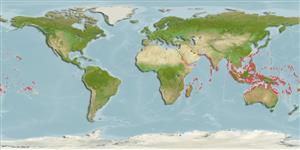Common names from other countries
Environment: milieu / climate zone / depth range / distribution range
Sinh thái học
Cùng sống ở rạn san hô; Mức độ sâu 3 - 10 m (Ref. 98622). Tropical; 30°N - 34°S, 27°E - 135°W (Ref. 846)
Indo-Pacific. Tropical to subtropical.
Length at first maturity / Bộ gần gũi / Khối lượng (Trọng lượng) / Age
Maturity: Lm ? range ? - ? cm Max length : 19.9 cm BRL con đực/không giới tính; (Ref. 269); common length : 2.5 cm BRW con đực/không giới tính; (Ref. 269)
A corymbose growth form distinguishes this spcies. Individual branches form fat fingers, 0.1-0.25 cm in diameter and less than 20 cm in length, with little secondary branching. Due to solid construction, these species is found on exposed reefs throughout its range in shallow to intermediate depths (Ref. 269).
Can be found in shallow waters (Ref. 122680). Found on exposed reefs throughout its range in shallow to intermediate depths (Ref. 269) on reef tops, upper slopes and submerged reefs (Ref. 86439). Also on reef flats (Ref. 98471).
Life cycle and mating behavior
Chín muồi sinh dục | Sự tái sinh sản | Đẻ trứng | Các trứng | Sự sinh sản | Ấu trùng
Hermaphroditic (Refs. 113708, 113712). Mature gametes are shed into the coelenteron and spawned through the mouth. Life cycle: The zygote develops into a planktonic planula larva. Metamorphosis begins with early morphogenesis of tentacles, septa and pharynx before larval settlement on the aboral end (Ref. 833).
Wallace, C.C. 1999. (Ref. 86439)
IUCN Red List Status (Ref. 130435)
CITES status (Ref. 108899)
Not Evaluated
Human uses
| FishSource |
Các công cụ
Các nguồn internet
Estimates based on models
Preferred temperature
(Ref.
115969): 24.9 - 29.3, mean 28.4 (based on 3133 cells).
Vulnerability
Low vulnerability (10 of 100).
Price category
Unknown.
